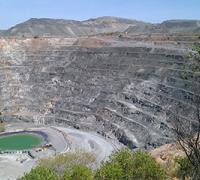Danish-Greenlandic declaration on nuclear safeguards
On 1 February 2016, a joint declaration on nuclear safeguards between the Danish Ministry of Foreign Affairs (MFA) and the Greenlandic Department of Industry, Labour and Trade (DILT) was published. It marked the end of two years of talks which focused on clarifying authorities and tasks between the two in relation to Greenland’s production and export of uranium. The declaration spells out how Greenland and Denmark will administratively structure a system for uranium governance to ensure compliance with the ‘Commonwealth of the Realm’ or the Rigsfællessab’s international safeguards obligations. It serves as the political basis for forthcoming legislation on nuclear safeguards to be debated in both parliaments in the coming months.
Who is responsible for what?
Denmark ratified the Treaty on the Non-Proliferation of Nuclear Weapons (NPT) in January 1969. Four years later when Denmark joined the European Economic Community (EEC), the Kingdom became party to INFCIRC/193 – the safeguards agreement between the non-nuclear weapon States of Euratom, Euratom and the International Atomic Energy Agency (IAEA). In 1985 Greenland withdrew from the EEC and returned to the safeguards agreement (INFCIRC/176) that the Kingdom had with the IAEA previously. Since 1998, Denmark has also applied an Additional Protocol (INFCIRC/540) to its safeguards agreement. The Additional Protocol is an addition to the safeguards agreement which grants broader information on (and IAEA access to) a State’s domestic uranium production, as well as data on trade in secondary materials that may contain uranium or thorium. Since March 2013, the Additional Protocol also applies to Greenland.
Although Denmark and Greenland have different agreements with the IAEA, both are comprehensive safeguards with the Additional Protocol and thus share the same reporting requirements on natural uranium. The main difference between their safeguards obligations is that provisions related to Commission Regulation (Euratom) No. 302/2005 of 8 February 2005 on the application of Euratom Safeguards do not apply to Greenland. The Regulation states that the basic technical characteristics of ore extraction operations should be declared and that accounting records of ore quantities extracted, including average uranium and thorium content and the stock at mines, should be kept for at least five years. The Regulation also requires annual declarations on the amount of material shipped from each mine or exported from the state. It is important to note that, under Regulation 302/2005, natural uranium is subject to the same reporting requirements as any other nuclear material – Material Balance Report, Physical Inventory Listing, Advance Notification of Imports/ Exports, and so on.
According to the joint Danish-Greenlandic safeguards declaration, Denmark and Greenland have agreed that safeguards implementation will apply definitions that correspond to Regulation 302/2005, including for accounting and control, reporting rules for uranium ore producers, and reporting of waste. There is also an agreement to apply future amendments to the Regulation as desired and agreed upon by both parties. Denmark and Greenland have therefore agreed to streamline already existing definitions and practices into their joint implementation.
Rigs Authority
The joint declaration on safeguards identifies the MFA as the ‘State Regulatory Authority,’ dealing directly with the IAEA on nuclear safeguards. The MFA is therefore the Rigs authority for safeguarding nuclear materials in Greenland and the Rigsfællesskab as a whole. The Danish Emergency Management Agency (DEMA, or Beredsskabstyrelsen) is identified as the administrative authority, responsible for the establishment and maintenance of a joint electronic nuclear accountancy system as a part of the overall State System of Accounting for and Control of Nuclear Material (SSAC). DEMA will also undertake inspections on behalf of the State Regulatory Authority, verifying information and confirming compliance at facilities subject to safeguards in Greenland.
Jointly Administered
The joint declaration emphasizes the essential role of Greenland, specifically DILT, in ensuring that the production and trade of Greenlandic uranium is used only for peaceful purposes. DEMA and DILT will cooperate to ensure the common electronic accountancy system is able to account for and detect any unauthorised use or removal of nuclear material. DILT will receive, compile and validate data from operators in Greenland and input it directly into the system on an ongoing basis or as requested by the State Regulatory Authority. DILT also assists operators in Greenland to ensure they fulfill their safeguards obligations, including accountancy and reporting requirements. Operators will be required to notify both the State Regulatory and Greenlandic authorities in advance of national and international transport of nuclear material, including the end-user destination and when shipment is received at that destination. The State Regulatory Authority in turn notifies the IAEA of exports (and imports) of nuclear material.
The joint declaration underscores that inspectors from the authorities in Denmark, Greenland and the IAEA have access to all locations and material subject to safeguards. DILT will accompany inspectors from DEMA, with follow-up done by DEMA and the State Regulatory Authority in coordination with DILT. DILT can also perform inspections on behalf of the State Regulatory Authority. This includes scheduled inspections, but may also include short-notice or unannounced inspections. There is also an understanding by both parties that safeguards authorities in Denmark and Greenland should function independently without undue influence and with the appropriate resources and technical skills to carry out their respective roles.
In terms of enforcement, the provisions of the Criminal Act of Greenland will apply to offences, such as theft or illicit trafficking of radioactive materials. The joint declaration also notes that forthcoming legislation on safeguards will include enforcement provisions.
Lastly, the safeguards declaration expresses joint agreement that all uranium exports are subject to a mellemstatslige modtagerstatsaftaler, or a bilateral agreement known commonly as a Nuclear Cooperation Agreement (NCA). These NCAs provide further assurances regarding peaceful uses and will be prepared by the Danish MFA in coordination with DILT. The NCAs are signed by the Danish government and, to the widest extent possible, together with Naalakkersuisut in accordance with paragraph 13 subsection 3 of the Self Government Act.

